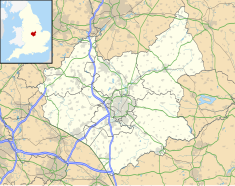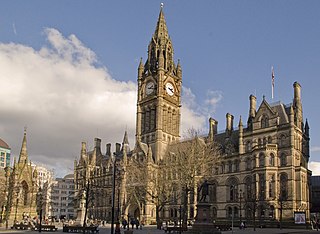
Manchester Town Hall is a Victorian, Neo-gothic municipal building in Manchester, England. It is the ceremonial headquarters of Manchester City Council and houses a number of local government departments. The building faces Albert Square to the north and St Peter's Square to the south, with Manchester Cenotaph facing its southern entrance.

Leicester City Centre is Leicester's historical commercial, cultural and transport hub and is home to its central business district. Its inner core is roughly delineated by the A594, Leicester's inner ring road, although the various central campuses of the University of Leicester, De Monfort University and Leicester College are adjacent to the inner ring road and could be considered to be a continuation of the City centre. In a similar way, the Leicester Royal Infirmary precinct, the New Walk business district (Southfields), the Welford Road Stadium of Leicester Tigers' RUFC and the King Power Stadium of Premier League Leicester City to the south, and the Golden Mile to the north could also be deemed to be extensions to the central core.

Leicester Town Hall stands at Town Hall Square in the city centre of Leicester, England. The building, which is the meeting place of Leicester City Council, is a Grade II* listed building.

Watford Colosseum is an entertainment venue in Watford, Hertfordshire, England. Established in 1938, as the Assembly Rooms for Watford Town Hall, the complex was extended in 2011 with improvements which included new meeting spaces, a new restaurant and new bar facilities.

The County Offices, also known as County Hall, is a municipal building in Stricklandgate, Kendal, Cumbria, England. The structure, which was the headquarters of Westmorland County Council from 1939 to 1974, is a Grade II listed building. The building serves as the meeting place of Westmorland and Furness Council.

Motherwell Civic Centre is a municipal building in Windmillhill Street in Motherwell, North Lanarkshire, Scotland. The building, which is the headquarters of North Lanarkshire Council, is a Category B listed building.
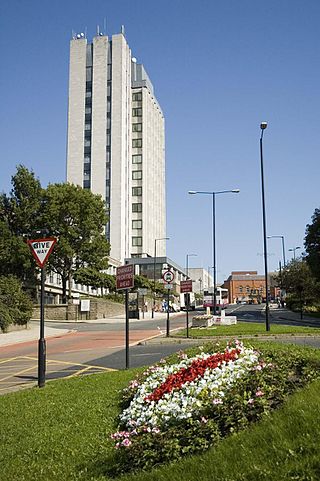
Oldham Civic Centre is a municipal building in West Street, Oldham, England.

The Town Hall, Christchurch is a municipal building in Christchurch, Dorset, England. The building, which incorporates a room known as the mayor's parlour on the first floor, and is a Grade II listed building. It is currently the base of Christchurch Town Council.

Llangefni Town Hall is a civic building dating back to the mid 19th-century, in the town of Llangefni, Anglesey, Wales. It is a Grade II listed building.

The Old Town Hall, sometimes referred to as the Moot Hall, is a municipal building in Church Street, Clitheroe, Lancashire, England. The structure, which was the meeting place of Clitheroe Borough Council, is a Grade II listed building.
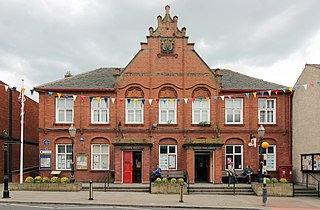
Neston Town Hall is a municipal building on High Street, Neston, Cheshire, England. The structure accommodates the offices and the meeting place of Neston Town Council.

Hawick Town Hall is a municipal building in the High Street, Hawick, Scotland. The structure, which served as the meeting place of Hawick Burgh Council, is a Category A listed building.
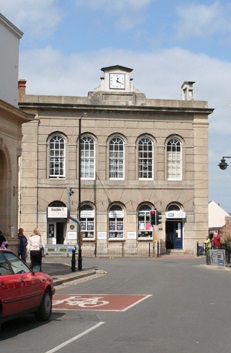
Wellington Town Hall is a municipal building in Fore Street, Wellington, Somerset, England. The structure, which was previously used as a civic events venue, is a Grade II listed building.

The Old Town Hall is a building on Church Street in the market town of Poulton-le-Fylde in Lancashire, England. The building, which is located just beyond the northern end of Market Place, started life as a public house before becoming a municipal building and then reverting to use as a public house.

Ashby-de-la-Zouch Town Hall is a municipal building in Market Street in Ashby-de-la-Zouch, Leicestershire, England. The structure, which was used as the offices of Ashby-de-la-Zouch Urban District Council, is a Grade II listed building. The market hall, which is located behind the town hall, is separately listed.

Berkhamsted Civic Centre is a municipal building in the High Street in Berkhamsted in Hertfordshire, England. The structure accommodates the offices and meeting place of Berkhamsted Town Council.

The Old Town House is a municipal building in the High Street in Old Aberdeen, Scotland. The structure, which is now the home of the King's Museum, is a Category A listed building.

Woking Civic Offices is a municipal building in Gloucester Walk, Woking, Surrey, England. It is in use as the headquarters of Woking Borough Council.

Chapel-en-le-Frith Town Hall is a municipal building in Market Street, Chapel-en-le-Frith, Derbyshire, England. The structure operates as a community events venue, as well as the offices and meeting place of Chapel-en-le-Frith Parish Council.

